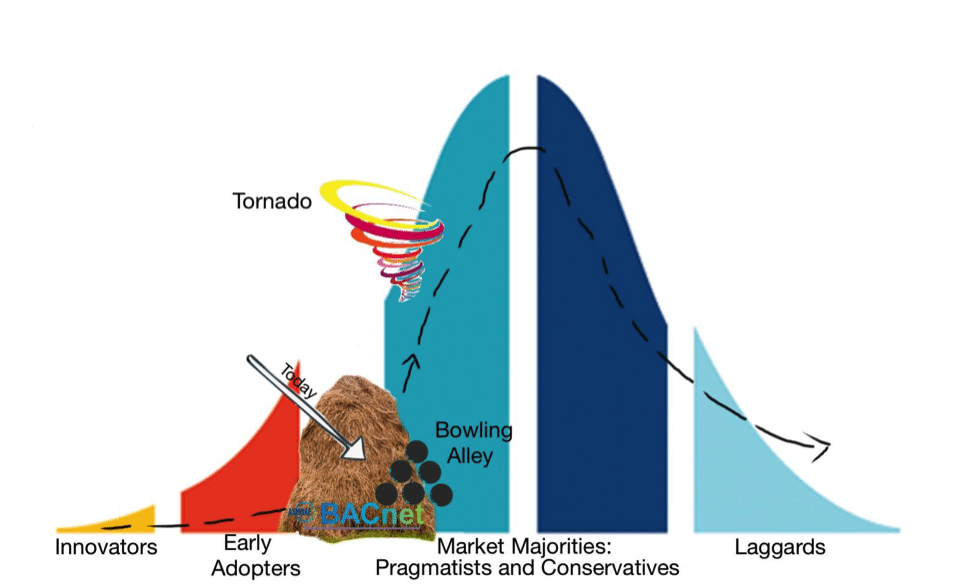
The most prominent feature of Geoffrey Moore’s Chasm theory is the gap in market momentum that is often observed once demand for a new innovation has played out among technology enthusiasts and has not caught on among more pragmatic and conservative buyers. That’s the Chasm.
Industry players mutually supporting common standards is a powerful force for getting across that gap and finding lucrative ‘Main Street’ markets. Those industry participants that make it across are in a good position to experience a ‘Tornado-like’ fast-moving, up-spiral in demand for their products and services.
At this moment in the Building Automation & Control industry, it’s fair to ask “Has support for standardization efforts like BACnet and Project Haystack naming / tagging taxonomy grown to the point that it is providing a pathway for data-driven building operations technologies across the Chasm?”
Good evidence that building operation analytics has made it to the much-safer “Bowling Alley” side of the divide is that customers are demanding and our industry is delivering “Whole Products.” Moore defines a “ Whole Product” as “all the complementary software applications, devices and services needed to fill out a core product to deliver compelling value to ‘Main Street.”
An article this month by Alper Uzmezier of BASSG details all the products and services that the SkySpark™ Ecosystem is delivering to make it more turn-key for system integrators to deploy an analytics solution for their customers. Likewise, an article from Greg Shank of Altura Associates presents why the combination of commissioning services plus analytics is remaking the entire design / construction cycle and setting the stage — ie, defining the software platform for — ongoing energy management and commissioning.

‘Chasm-speak’ uses the term Bowling Alley to convey the thought that technological innovations like the analytics-to-action cycle that Uzmezier describes and the next-gen energy management system that Shank describes take hold, market segment by market segment. It will take strong ecosystems of value-add software and service providers to deliver whole products at the right price / performance points for all the building types and geographies that comprise the existing built environment.
For this reason, the B-IoT industry could spend a long time in all the potential lanes of our Bowling Alley. But, cumulatively they have potential to drive a very big market transformation, i.e. Tornado.
My Chasm thinking was also informed by a Memoori podcast this month featuring Project Haystack participants Marc Petock and John Petze, moderated by James McHale. Here too, I learned that Fortune 50 companies are expressing high interest in Haystack. Does it get more Mainstreet than that? So I followed up with Petock and Petze, asking their thoughts about where the industry is on the Chasm curve.
John Petze offered this response: “Haystack is an enabling technology that is helping to lower the cost and accelerate the development of "Whole Products". We are seeing evidence of analytics crossing the chasm to the mainstream — that is something I would not have said a year or two ago. We continue to work with major owners and property management companies on new analytics projects of increasing scale. Mainstream providers of enterprise real estate management services and technology are demonstrating acceptance, and we have many end users that fit the definition of “mainstream”. My read of the Tornado phase is that it applies when a technology "takes off" in the mainstream with dramatic growth. I do not think we are seeing that quite yet. I see us being in the early mainstream market with the potential for a Tornado in the next 2 years. Today, we see the Tornado approaching — it’s getting dark outside with forecasts of heavy rain, strong winds and damaging hail —but, no tornados yet. I also think that the outsize presence of analytics companies at events like Realcomm (I believe that there were 10) holds a message about where the market is. Probably worth going back to the Chasm books to see what Geoffrey Moore has to say about shake-out in a new market and what that says about the stage of the market.”
[contact-form-7 id="3204" title="memoori-newsletter"]
Marc Petock largely concurred that the basic building block technologies for the Buildings IoT are across the Chasm. He added, “Haystack is radical new thinking about data. This change must begin at the most basic levels, with new conceptions about how devices, information, people and systems interact. I believe that Haystack is delivering business relevant outcomes that are driving new value in a built environment. Common protocols and naming are securing the interoperability of related connected systems, devices and things.
They are making the data contained within them self-describing and enabling seamless integration across multiple applications to improve operations, reduce costs and maximize occupant experiences. Value from data will only be realized if organizations can understand and leverage the data they produce. By creating value from the data generated, companies can improve operations, reduce costs, and enable valuable customer experiences.”
I’ve found the Chasm terms and explanations ring fairly true for understanding the dynamics of why, how and when technology markets transform. Maybe because Moore makes such great use of the bell curve. (ha ha) What do you think? Write me at therese@buildingcontext.me.



